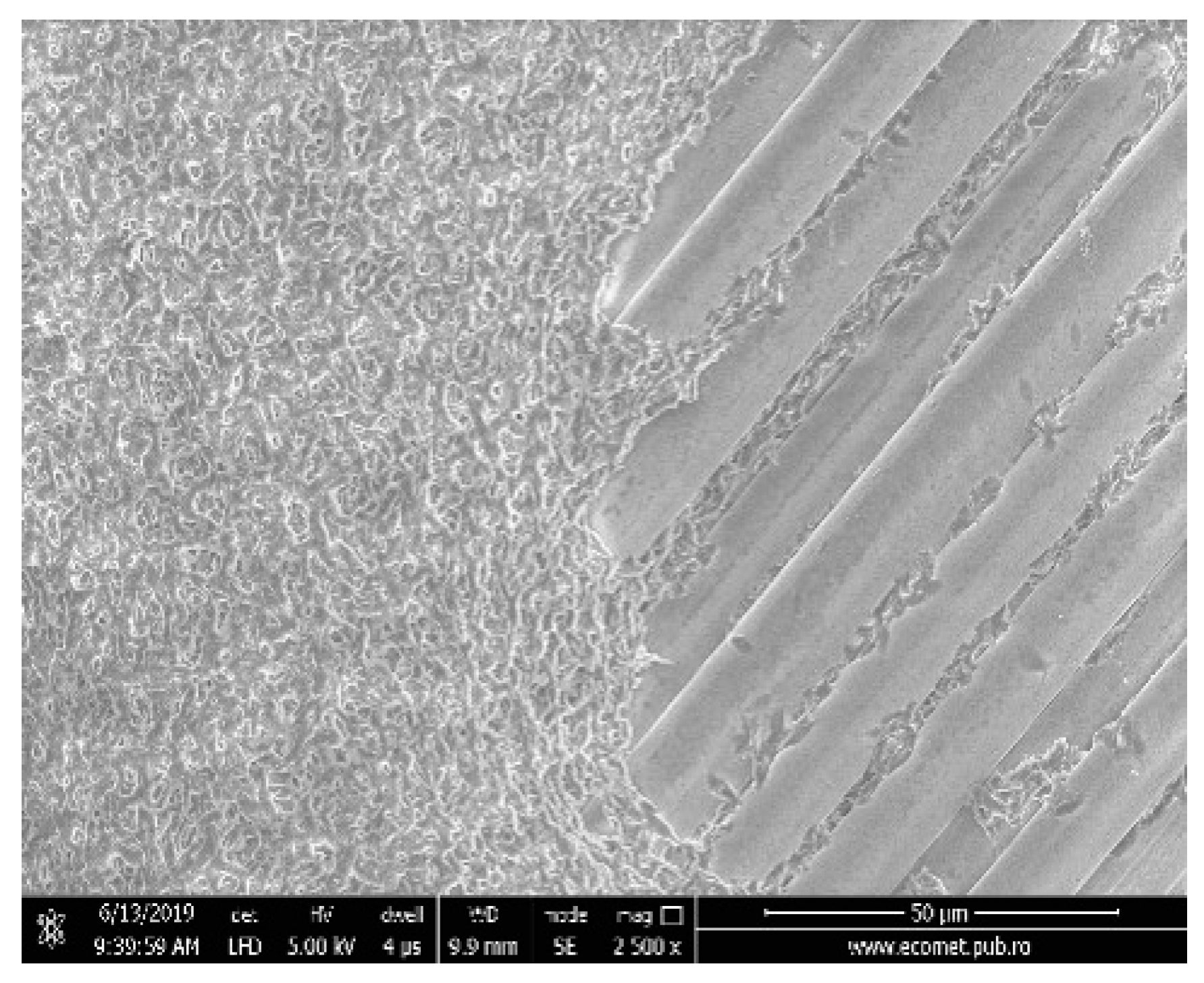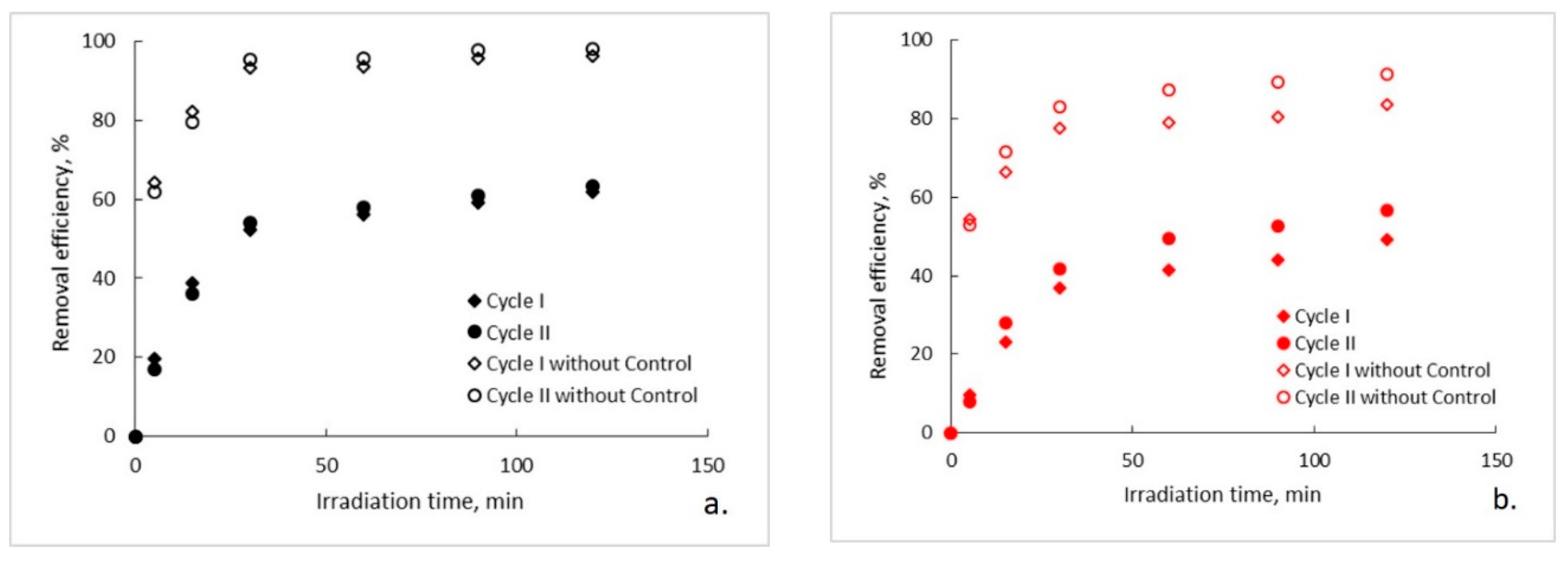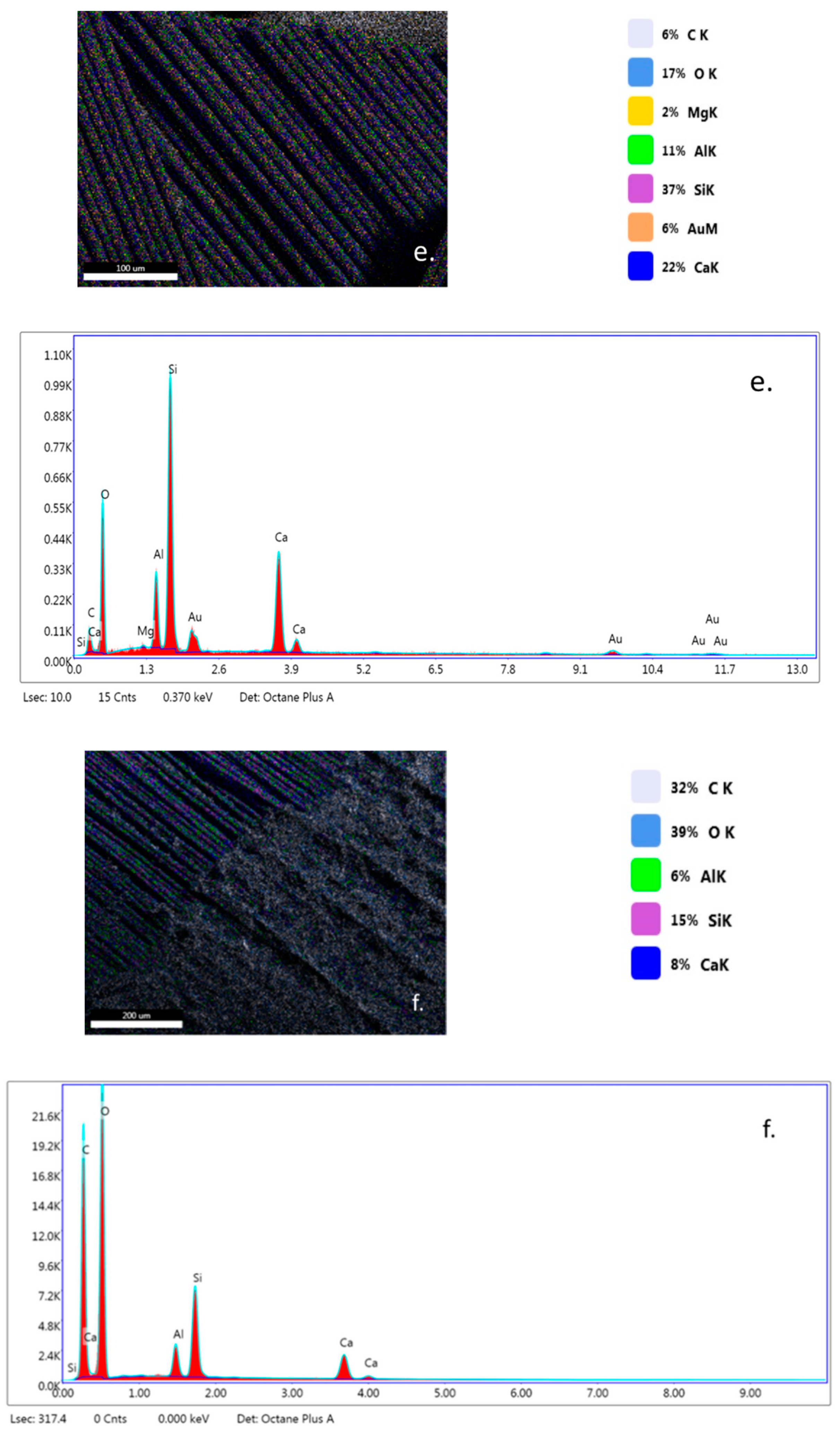Photocatalytic Degradation of Ampicillin Using PLA/TiO2 Hybrid Nanofibers Coated on Different Types of Fiberglass
Abstract
1. Introduction
2. Materials and Methods
2.1. Materials
2.2. Preparation of the PLA/TiO2 Solutions
2.3. Pretreatment of Fiberglass Supports with Polylactic Acid (PLA) Solution
2.4. Electrospinning
2.5. Photocatalytic Experiments
2.6. Photocatalytic Membranes Characterization
3. Results and Discussion
3.1. Photocatalytic Degradation of Ampicillin
3.2. Degradation Kinetics
3.3. Characterization of Photocatalytic Membranes
3.3.1. Scanning Electron Microscopy–Energy-Dispersive X-ray (SEM–EDX) Results
3.3.2. X-ray Diffraction (XRD) Results
3.3.3. Attenuated Total Reflectance (ATR) Fourier Transform Infrared (FT–IR) Results
4. Conclusions
- The kinetic results showed that after 30 min of photocatalysis almost all ampicillin is removed from the aqueous solution, the best results being recorded for fiberglass fabric plain woven-type membrane.
- PLA/TiO2 hybrid nanofibers exhibit reduced stability under the reactive conditions of the photocatalytic reactor, their instability being closely related to the type of fiberglass used as a support.
- The tendency of PLA degradation during photocatalysis, evidenced both by SEM-EDX, XRD, FT–IR and kinetic studies, has a direct effect on the photocatalytic oxidation potential of the membranes used.
- The main limitations of using PLA/TiO2 photocatalyst are the degradation of PLA under the photocatalytic conditions used (UV radiation, pH 3, hydrogen peroxide/ampicillin molar ratio of 1.5) and the need to work at low pH values compared to the pH value of the natural waters in order to obtain high degradation efficiency of the ampicillin (as previous photocatalytic studies have demonstrated the decrease of the efficiency of degradation of the organic material with the increase of the pH value of the aqueous system subjected to treatment).
Supplementary Materials
Author Contributions
Funding
Acknowledgments
Conflicts of Interest
References
- Pazda, M.; Kumirska, J.; Stepnowski, P.; Mulkiewicz, E. Antibiotic resistance genes identified in wastewater treatment plant systems—A review. Sci. Total Environ. 2019, 697, 134023. [Google Scholar] [CrossRef] [PubMed]
- Osińska, A.; Korzeniewska, E.; Harnisz, M.; Felis, E.; Bajkacz, S.; Jachimowicz, P.; Niestępski, S.; Konopka, I. Small-scale wastewater treatment plants as a source of the dissemination of antibiotic resistance genes in the aquatic environment. J. Hazard. Mater. 2020, 381, 121221. [Google Scholar] [CrossRef] [PubMed]
- Voigt, A.M.; Zacharias, N.; Timm, C.; Wasser, F.; Sib, E.; Skutlarek, D.; Parcina, M.; Schmithausen, R.M.; Schwartz, T.; Hembach, N.; et al. Association between antibiotic residues, antibiotic resistant bacteria and antibiotic resistance genes in anthropogenic wastewater—An evaluation of clinical influences. Chemosphere 2020, 241, 125032. [Google Scholar] [CrossRef]
- Almakki, A.; Jumas-Bilak, E.; Marchandin, H.; Licznar-Fajardo, P. Antibiotic resistance in urban runoff. Sci. Total Environ. 2019, 667, 64–76. [Google Scholar] [CrossRef] [PubMed]
- Wang, T.; Ai, S.; Zhou, Y.; Luo, Z.; Dai, C.; Yang, Y.; Zhang, J.; Huang, H.; Luo, S.; Luo, L. Adsorption of agricultural wastewater contaminated with antibiotics, pesticides and toxic metals by functionalized magnetic nanoparticles. J. Environ. Chem. Eng. 2018, 6, 6468–6478. [Google Scholar] [CrossRef]
- Nasseh, N.; Barikbin, B.; Taghavi, L.; Nasseri, M.A. Adsorption of metronidazole antibiotic using a new magnetic nanocomposite from simulated wastewater (isotherm, kinetic and thermodynamic studies). Compos. Part B Eng. 2019, 159, 146–156. [Google Scholar] [CrossRef]
- Wei, Z.; Liu, J.; Fang, W.; Xu, M.; Qin, Z.; Jiang, Z.; Shangguan, W. Photocatalytic hydrogen evolution with simultaneous antibiotic wastewater degradation via the visible-light-responsive bismuth spheres-g-C3N4 nanohybrid: Waste to energy insight. Chem. Eng. J. 2019, 358, 944–954. [Google Scholar] [CrossRef]
- Fiorentino, A.; Esteban, B.; Garrido-Cardenas, J.A.; Kowalska, K.; Rizzo, L.; Aguera, A.; Pérez, J.A.S. Effect of solar photo-Fenton process in raceway pond reactors at neutral pH on antibiotic resistance determinants in secondary treated urban wastewater. J. Hazard. Mater. 2019, 378, 120737. [Google Scholar] [CrossRef]
- Leng, L.; Wei, L.; Xiong, Q.; Xu, S.; Li, W.; Lv, S.; Lu, Q.; Wan, L.; Wen, Z.; Zhou, W. Use of microalgae based technology for the removal of antibiotics from wastewater: A review. Chemosphere 2020, 238, 124680. [Google Scholar] [CrossRef]
- Kebede, T.G.; Dube, S.; Nindi, M.M. Removal of multi-class antibiotic drugs from wastewater using water-soluble protein of Moringa stenopetala seeds. Water 2019, 11, 595. [Google Scholar] [CrossRef]
- Hou, J.; Chen, Z.; Gao, J.; Xie, Y.; Li, L.; Qin, S.; Wang, Q.; Mao, D.; Luo, Y. Simultaneous removal of antibiotics and antibiotic resistance genes from pharmaceutical wastewater using the combinations of up-flow anaerobic sludge bed, anoxic-oxic tank, and advanced oxidation technologies. Water Res. 2019, 159, 511–520. [Google Scholar] [CrossRef] [PubMed]
- Nguyen-Phan, T.-D.; Shin, E.W. Morphological effect of TiO2 catalysts on photocatalytic degradation of methylene blue. J. Ind. Eng. Chem. 2011, 17, 397–400. [Google Scholar] [CrossRef]
- Jiménez-Tototzintle, M.; Ferreira, I.J.; da Silva Duque, S.; Barrocas, P.R.G.; Saggioro, E.M. Removal of contaminants of emerging concern (CECs) and antibiotic resistant bacteria in urban wastewater using UVA/TiO2/H2O2 photocatalysis. Chemosphere 2018, 210, 449–457. [Google Scholar] [CrossRef]
- Biancullo, F.; Moreira, N.F.F.; Ribeiro, A.R.; Manaia, C.M.; Faria, J.L.; Nunes, O.C.; Castro-Silva, S.M.; Silva, A.M.T. Heterogeneous photocatalysis using UVA-LEDs for the removal of antibiotics and antibiotic resistant bacteria from urban wastewater treatment plant effluents. Chem. Eng. J. 2019, 367, 304–313. [Google Scholar] [CrossRef]
- Moreira, N.F.F.; Narciso-da-Rocha, C.; Polo-López, M.I.; Pastrana-Martínez, L.M.; Faria, J.L.; Manaia, C.M.; Fernández-Ibáñez, P.; Nunes, O.C.; Silva, A.M.T. Solar treatment (H2O2, TiO2-P25 and GO-TiO2 photocatalysis, photo-Fenton) of organic micropollutants, human pathogen indicators, antibiotic resistant bacteria and related genes in urban wastewater. Water Res. 2018, 135, 195–206. [Google Scholar] [CrossRef]
- Han, D.; Steckl, A.J. Coaxial electrospinning formation of complex polymer fibers and their applications. Chempluschem 2019, 84, 1453–1497. [Google Scholar] [CrossRef]
- Kim, J.H.; Lee, J.H.; Kim, J.Y.; Kim, S.S. Synthesis of aligned TiO2 nanofibers using electrospinning. Appl. Sci. 2018, 8, 309. [Google Scholar]
- Tekmen, C.; Suslu, A.; Cocen, U. Titania nanofibers prepared by electrospinning. Mater. Lett. 2008, 62, 4470–4472. [Google Scholar] [CrossRef]
- Park, J.Y.; Choi, S.W.; Asokan, K.; Kim, S.S. Controlling the size of nanograins in TiO2 nanofibers. Met. Mater. Int. 2010, 16, 785–788. [Google Scholar] [CrossRef]
- Liu, M.; Cheng, Z.; Yan, J.; Qiang, L.; Ru, X.; Liu, F.; Ding, D.; Li, J. Preparation and characterization of TiO2 nanofibers via using polylactic acid as template. J. Appl. Polym. Sci. 2013, 128, 1095–1100. [Google Scholar] [CrossRef]
- Wang, Z.; Pan, Z.; Wang, J.; Zhao, R. A novel hierarchical structured poly(lactic acid)/titania fibrous membrane with excellent antibacterial activity and air filtration performance. J. Nanomater. 2016, 2016, 39. [Google Scholar] [CrossRef]
- Costa, R.G.F.; Brichi, G.S.; Ribeiro, C.; Mattoso, L.H.C. Nanocomposite fibers of poly(lactic acid)/titanium dioxide prepared by solution blow spinning. Polym. Bull. 2016, 73, 2973–2985. [Google Scholar] [CrossRef]
- Tarcea, C.I.; Predescu, C.; Matei, E.; Predescu, A.M.; Rapa, M.; Turcanu, A. Use of nano-anatase in degradation of heterocyclic dyes from waters. UPB Sci. Bull. Ser. B 2019, 81, 169–178. [Google Scholar]
- Abou-Elela, S.I.; El-Khateeb, M.A. Performance evaluation of activated sludge process for treating pharmaceutical wastewater contaminated with β-lactam antibiotics. J. Ind. Pollut. Control 2015, 31, 1–5. [Google Scholar]
- American Public Health Association; American Water Works Association; Water Environment Federation. Standard Methods for the Examination of Water and Wastewater, 18th ed.; American Public Health Association: Washington, DC, USA, 1992. [Google Scholar]
- Orbeci, C.; Modrogan, C.; Dăncilă, A.M. Degradation of pharmaceutical effluents by photo-assisted techniques. Rev. Chim. 2016, 67, 166–170. [Google Scholar]
- Man, C.; Zhang, C.; Liu, Y.; Wang, W.; Ren, W.; Jiang, L.; Reisdorffer, F.; Nguyen, T.P.; Dan, Y. Poly (lactic acid)/titanium dioxide composites: Preparation and performance under ultraviolet irradiation. Polym. Degrad. Stab. 2012, 97, 856–862. [Google Scholar] [CrossRef]
- Zaharescu, T.; Rapa, M.; Marinescu, V. Chemiluminescence kinetic analysis on the oxidative degradation of poly(lactic acid). J. Therm. Anal. Calorim. 2017, 128, 185–191. [Google Scholar] [CrossRef]
- Lee, K.M.; Abd Hamid, S.B.; Lai, C.W. Mechanism and kinetics study for photocatalytic oxidation degradation: A case study for phenoxyacetic acid organic pollutant. J. Nanomater. 2015, 2015, 9. [Google Scholar] [CrossRef]
- Ollis, D. Kinetic analysis of liquid phase photocatalysis and photolysis: A frequent disguise! Catal. Today 2020, 340, 7–11. [Google Scholar] [CrossRef]
- Elmolla, E.S.; Chaudhuri, M. Photocatalytic degradation of amoxicillin, ampicillin and cloxacillin antibiotics in aqueous solution using UV/TiO2 and UV/H2O2/TiO2 photocatalysis. Desalination 2010, 252, 46–52. [Google Scholar] [CrossRef]
- Elmolla, E.S.; Chaudhuri, M. Degradation of amoxicillin, ampicillin and cloxacillin antibiotics in aqueous solution by the UV/ZnO photocatalytic process. J. Hazard. Mater. 2010, 173, 445–449. [Google Scholar] [CrossRef] [PubMed]
- Alalm, M.G.; Tawfik, A.; Ookawara, S. Enhancement of photocatalytic activity of TiO2 by immobilization on activated carbon for degradation of pharmaceuticals. J. Environ. Chem. Eng. 2016, 4, 1929–1937. [Google Scholar] [CrossRef]
- Sharma, G.; Gupta, V.K.; Agarwal, S.; Bhogal, S.; Naushad, M.; Kumar, A.; Stadler, F.J. Fabrication and characterization of trimetallic nano-photocatalyst for remediation of ampicillin antibiotic. J. Mol. Liq. 2018, 260, 342–350. [Google Scholar] [CrossRef]
- Raizada, P.; Kumari, J.; Shandilya, P.; Dhiman, R.; Singh, V.P.; Singh, P. Magnetically retrievable Bi2WO6/Fe3O4 immobilizedon graphene sand composite for investigation of photocatalytic mineralization of oxytetracycline and ampicillin. Process Saf. Environ. Prot. 2017, 106, 104–116. [Google Scholar] [CrossRef]
- Rapa, M.; Stefan, L.M.; Preda, P.; Darie-Nita, R.N.; Gaspar-Pintiliescu, A.; Seciu, A.M.; Vasile, C.; Matei, E.; Predescu, A.M. Effect of hydrolyzed collagen on thermal, mechanical and biological properties of poly(lactic acid) bionanocomposites. Iran. Polym. J. 2019, 28, 271–282. [Google Scholar] [CrossRef]
- Ramos, M.; Fortunati, E.; Peltzer, M.; Dominici, F.; Jiménez, A.; Garrigós, M.C.; Kenny, J.M. Influence of thymol and silver nanoparticles on the degradation of poly (lactic acid) based nanocomposites: Thermal and morphological properties. Polym. Degrad. Stab. 2014, 108, 158–165. [Google Scholar] [CrossRef]












| Reactor Volume, L | 1.5 |
| Ampicillin working solution volume, L | 2 |
| Recirculation flow rate, L/min | 1 |
| Power or the UV lamp, W | 120 |
| Ampicillin solution pH | 3 |
| Hydrogen peroxide/ampicillin molar ratio | 1.5 |
| Membranes | Fiberglass fabric plain woven-type (EWR; E-glass) |
| Fiberglass mat-type (EMC; E-glass) | |
| Fiberglass fabric one fold edge-type (TEX, E-glass) |
| Membrane | Cycle I | Cycle II | ||
|---|---|---|---|---|
| Experimental, % | Theoretic *, % | Experimental, % | Theoretic *, % | |
| Fiberglass fabric plain woven-type membrane (EWR) | 52.2 | 93.1 | 54.0 | 95.2 |
| Fiberglass mat-type membrane (EMC) | 36.8 | 77.7 | 41.9 | 83.0 |
| Fiberglass fabric one fold edge-type membrane (TEX) | 38.1 | 79.7 | 34.3 | 75.9 |
| Kinetic Parameter | Fiberglass Fabric Plain Woven-Type Membrane (EWR) | Fiberglass Mat-Type Membrane (EMC) | Fiberglass Fabric One Fold Edge-Type Membrane (TEX) | |||
|---|---|---|---|---|---|---|
| 0–30 min | ||||||
| Cycle I | Cycle II | Cycle I | Cycle II | Cycle I | Cycle II | |
| kobs, min−1 | 0.027 | 0.027 | 0.016 | 0.019 | 0.017 | 0.014 |
| R2 | 0.9379 | 0.9379 | 0.9888 | 0.9847 | 0.9515 | 0.989 |
| r0, mg/L·min | 7.857 | 7.803 | 4.656 | 5.491 | 4.862 | 4.004 |
| 30–120 min | ||||||
| kobs, min−1 | 0.0024 | 0.0024 | 0.0023 | 0.0026 | 0.0026 | 0.0025 |
| R2 | 0.9998 | 0.9973 | 0.951 | 0.9892 | 0.9316 | 0.9867 |
| r0, mg/L·min | 0.264 | 0.264 | 0.253 | 0.286 | 0.286 | 0.275 |
| Cycle I, Irradiation Interval 0–30 min | ||||||||
| MeanDiff | SEM | q Value | Prob | Alpha | Sig | LCL | UCL | |
| TEX—EWR | −0.01090 | 0.00178 | 8.65031 | 0.00211 | 0.05 | 1 | −0.01637 | −0.00543 |
| EMC—EWR | −0.00963 | 0.00178 | 7.64507 | 0.00399 | 0.05 | 1 | −0.01510 | −0.00417 |
| EMC—TEX | 0.00127 | 0.00178 | 1.00523 | 0.7664 | 0.05 | 0 | −0.00420 | 0.00673 |
| Cycle I, Irradiation Interval 30–120 min | ||||||||
| TEX—EWR | 2.00 × 10−4 | 4.03 × 10−4 | 0.70105 | 0.95782 | 0.05 | 0 | −0.00109 | 0.00149 |
| EMC—EWR | −6.67 × 10−5 | 4.03 × 10−4 | 0.23368 | 0.99826 | 0.05 | 0 | −0.00136 | 0.00123 |
| EMC—TEX | −2.67 × 10−4 | 4.03 × 10−4 | 0.93473 | 0.90877 | 0.05 | 0 | −0.00156 | 0.00103 |
| C (EWR)—EWR | −3.33 × 10−5 | 4.03 × 10−4 | 0.11684 | 0.99978 | 0.05 | 0 | −0.00133 | 0.00126 |
| C (EWR)—TEX | −2.33 × 10−4 | 4.03 × 10−4 | 0.81789 | 0.93584 | 0.05 | 0 | −0.00153 | 0.00106 |
| C (EWR)—EMC | 3.33 × 10−5 | 4.03 × 10−4 | 0.11684 | 0.99978 | 0.05 | 0 | −0.00126 | 0.00133 |
| Photocatalytic System | kobs, min−1 | Removal Efficiency, % | Reference |
|---|---|---|---|
| Ultraviolet (UV)/H2O2/TiO2 (suspension); TiO2: 1 g/L; Time: 30 min | 0.003 | 100 | [31] |
| UV/ZnO (suspension); ZnO: 0.5 g/L, Time: 180 min | 0.015 | 100 | [32] |
| Sunlight/TiO2 (suspension); TiO2: 0.6 mg/L, Time: 180 min | 0.011 | 89 | [33] |
| Sunlight/TiO2/AC (activated carbon) (suspension); TiO2: 0.4 mg/L, Time: 180 min | 0.022 | 100 | |
| Sunlight/La/Cu/Zr TNPs (trimetallics nanoparticles) (suspension); 100 mg/reactor load; | 0.00627 | 86 | [34] |
| Sunlight/Bi2WO6/Fe3O4/GSC (grapheme sand composite) (suspension); 0.5 g/L; Time: 60 min | 0.0037 | 95 | [35] |
| Sunlight/Bi2WO6/Fe3O4 (suspension); 0.5 g/L; Time: 60 min | 0.002 | 74 | |
| UV/TiO2/PLA/Fiberglass fabric plain woven-type membrane (EWR) (deposited TiO2); 0.06 g TiO2/membrane; Time: 30 min | 0.027 | 95.2 | This work |
| UV/TiO2/PLA/Fiberglass mat-type membrane (EMC) (deposited TiO2); 0.06 g TiO2/membrane; Time: 30 min | 0.019 | 83 | |
| UV/TiO2/PLA/Fiberglass fabric one fold edge-type membrane (TEX) (deposited TiO2); 0.06 g TiO2/membrane; Time: 30 min | 0.017 | 79.7 |
© 2020 by the authors. Licensee MDPI, Basel, Switzerland. This article is an open access article distributed under the terms and conditions of the Creative Commons Attribution (CC BY) license (http://creativecommons.org/licenses/by/4.0/).
Share and Cite
Bobirică, C.; Bobirică, L.; Râpă, M.; Matei, E.; Predescu, A.M.; Orbeci, C. Photocatalytic Degradation of Ampicillin Using PLA/TiO2 Hybrid Nanofibers Coated on Different Types of Fiberglass. Water 2020, 12, 176. https://doi.org/10.3390/w12010176
Bobirică C, Bobirică L, Râpă M, Matei E, Predescu AM, Orbeci C. Photocatalytic Degradation of Ampicillin Using PLA/TiO2 Hybrid Nanofibers Coated on Different Types of Fiberglass. Water. 2020; 12(1):176. https://doi.org/10.3390/w12010176
Chicago/Turabian StyleBobirică, Constantin, Liliana Bobirică, Maria Râpă, Ecaterina Matei, Andra Mihaela Predescu, and Cristina Orbeci. 2020. "Photocatalytic Degradation of Ampicillin Using PLA/TiO2 Hybrid Nanofibers Coated on Different Types of Fiberglass" Water 12, no. 1: 176. https://doi.org/10.3390/w12010176
APA StyleBobirică, C., Bobirică, L., Râpă, M., Matei, E., Predescu, A. M., & Orbeci, C. (2020). Photocatalytic Degradation of Ampicillin Using PLA/TiO2 Hybrid Nanofibers Coated on Different Types of Fiberglass. Water, 12(1), 176. https://doi.org/10.3390/w12010176








